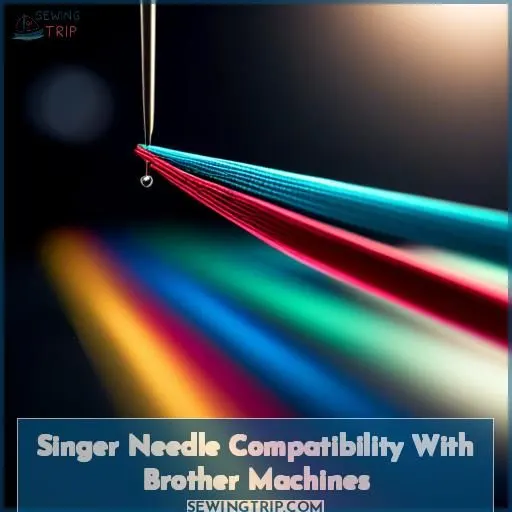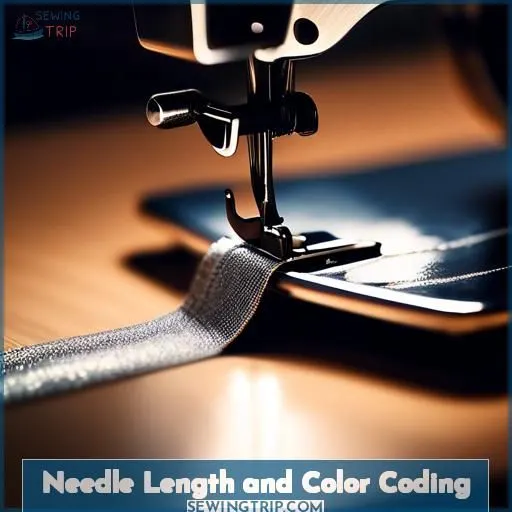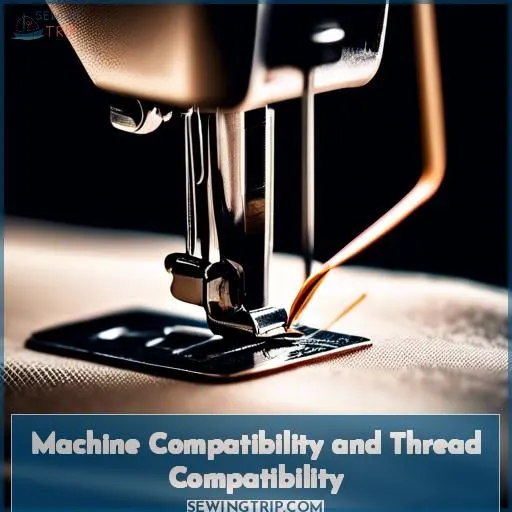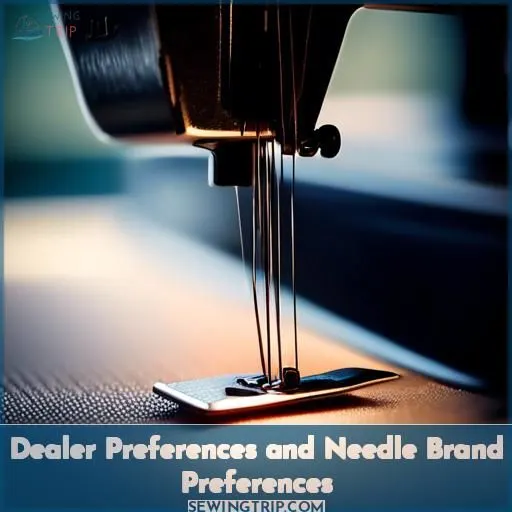This site is supported by our readers. We may earn a commission, at no cost to you, if you purchase through links.

You can use a Singer needle in a Brother machine.
Both brands utilize the universal 15×1 needle system, ensuring compatibility.
However, Singer needles may be slightly longer than other brands.
While this marginal length difference likely won’t affect performance, you’ll want to double-check that the Singer needle properly inserts into your specific Brother model’s needle bar.
Color-coding on Singer needles denotes the point type and size, helping you select the appropriate needle for your project.
If you’d like to explore further details on optimizing needle choices across different machines and fabric types, the following sections provide additional insights.
Table Of Contents
- Key Takeaways
- Can I Use a Singer Needle in a Brother Machine?
- Singer Needle Compatibility With Brother Machines
- Needle Length and Color Coding
- Machine Compatibility and Thread Compatibility
- Dealer Preferences and Needle Brand Preferences
- Needle Performance and Machine Preferences
- Frequently Asked Questions (FAQs)
- Conclusion
Key Takeaways
- Both Singer and Brother machines use the universal 15×1 needle system, ensuring compatibility between Singer needles and Brother machines.
- Singer needles may be slightly longer than other brands, which could potentially lead to compatibility issues with some machines, but generally, this difference does not affect performance in Brother machines.
- Singer needles feature a color-coding system to denote the point type and size, facilitating the selection of the appropriate needle for specific projects.
- It is recommended to consult the needle compatibility chart provided by Brother for your specific machine model to ensure optimal compatibility and performance.
Can I Use a Singer Needle in a Brother Machine?
Yes, you can use a Singer needle in a Brother machine. Singer needles are designed to be universal and can be used in various sewing machines, including Brother models.
Singer Needle Compatibility With Brother Machines
Yes, you can use a Singer needle in a Brother machine.
While Singer needles may be slightly longer than other brands, this difference should not pose a problem in a Brother machine.
The compatibility between Singer and Brother machines is generally good, and both brands use the same needle system (15×1).
However, it is always a good idea to check the needle compatibility chart provided by Brother for your specific machine model to ensure compatibility.
Needle Length and Color Coding
With regards to utilizing Singer needles in Brother machines, certain factors must be taken into account. Singer needles could have a marginal length advantage over other brands, potentially leading to compatibility issues with some machines. Nevertheless, most needles are versatile and suitable for use in various machines, including Brother models.
Singer needles employ color-coding to denote the point type and size. This system simplifies the identification of needle type without the need for deciphering numerals. For instance, yellow shanks represent ball points, red shanks signify sharps, while blue stripes indicate size 14 needles.
It is imperative to acknowledge that certain machines, such as Bernina and Viking, may not be compatible with Singer needles. European machines may be more prone to damage from Singer needles, and Viking machines are strongly discouraged from using them. Conversely, some Singer machines may exclusively accept Singer needles.
Regarding needle length, Singer needles may exceed the length of other brands, and extended needles can potentially damage Bernina machines. European machines may also exhibit increased susceptibility to damage from Singer needles. On the other hand, some Singer machines may only be compatible with Singer needles.
In terms of needle quality, there’s no substantial disparity between Singer and Schmetz needles. Standard needles, such as 15×1 12/80 sharp, are adequate for the majority of sewing projects. Schmetz provides a more comprehensive range of needle types, but the differences in quality and consistency among brands can vary.
Machine Compatibility and Thread Compatibility
When discussing machine compatibility, it’s vital to bear in mind the needle types, thread quality, and needle durability. Some machines, such as Bernina and Viking, may not be compatible with Singer needles due to their distinctive needle configurations. Conversely, Kenmore and Brother machines may accept Singer needles. To achieve optimal sewing results, it’s essential to align the needle size and style with your project. Needle sharpening and appropriate needle storage are also crucial to preserving needle quality.
Regarding thread compatibility, some machines may have specific thread recommendations. Employing higher-quality thread can save money in the long run by reducing the need for frequent needle replacements. Singer machines may have specific thread recommendations, and compatibility can vary depending on the machine. Coats and Clark thread may not be recommended for some machines, while maxi-lock thread may necessitate more cleanup in sergers.
Dealer Preferences and Needle Brand Preferences
When you’re on the hunt for the perfect needle, you might feel like you’re threading your way through a maze of manufacturer recommendations and market trends. Here’s a quick guide to help you stitch together the best choice:
- Dealer bias can sway you towards more expensive options, but remember, the proof is in the stitching, not the price tag.
- Brand loyalty runs deep, yet your machine might sing just as sweetly with a Schmetz needle as it would with a Singer.
- Manufacturer recommendations are worth a glance, but don’t let them pin down your consumer preference.
- Coats and Clark thread might be the talk of the town, but pairing it with the right 15×1 needles, regardless of the singer packaging, could be your secret to seamless sewing.
Needle Performance and Machine Preferences
Regarding needle performance and machine preferences, a few key aspects merit attention. Firstly, needle quality can vary across brands and types. While Singer and Schmetz needles may not exhibit substantial quality disparities, Schmetz provides a broader spectrum of needle types, advantageous for specialized projects.
Needle type and style hold importance. For instance, Singer needles may be optimal for knit fabrics, while Schmetz needles offer a diverse range designed for specific fabrics and threads. Utilizing appropriate needle types can enhance sewing outcomes by minimizing skipped stitches and snags, particularly with knit fabrics.
Needle threading and longevity warrant consideration. Some needles, such as Schmetz, possess a shortened shank and expanded diameter, beneficial for long-arm quilting. Utilize metallic needles for metallic threads, and Janome needles are compatible with Janome machines.
Machine preferences can also impact needle selection. For example, Bernina 1530 employs Schmetz needles, whereas Singer 401A requires Singer needles. Certain machines may have specific needle recommendations from their manufacturers; hence, consulting the manual or seeking assistance from a dealer is crucial.
Frequently Asked Questions (FAQs)
How long are Singer needles compared to other brands?
You might notice Singer needles are a tad longer than most brands. While this difference is slight, longer needles can potentially cause issues in European machines like Bernina or Viking models. But for domestic machines, the extra length usually isn’t a problem.
Can Singer needles damage a Bernina machine?
Yes, you should avoid using Singer needles in a Bernina machine. Singer needles are slightly longer and can potentially damage the hook area of a Bernina. It’s best to stick with Bernina or Schmetz needles for ideal performance and safety.
What color codes indicate point type and size in Singer needles?
You’ve hit the nail on the head – Singer needles have a color-coded system that makes identifying types and sizes a breeze. Yellow shanks signify ball points, while red means sharp points. Blue stripes indicate size 14, orange size 11, and purple size
Can European machines be damaged by Singer needles?
Yes, you’ll want to be cautious with Singer needles on European machines. Those manufacturers often have tighter tolerances, so the slightly longer Singer needles could potentially cause damage if they bind or misalign. Stick to the recommended needles to play it safe.
Are there specific needle recommendations for Singer machines?
Sure, you can absolutely use Singer needles in your Brother machine! But keep in mind, each brand has its own needle recommendations for best results. Check your manual or ask a pro – they’ll lead you right to get those stitches looking crisp every time.
Conclusion
Exploring the needle realm is akin to discovering the ideal key to unleash your sewing prowess.
While it’s feasible to employ a Singer needle in a Brother machine due to the universal 15×1 system, exercising caution by verifying compatibility guarantees a harmonious interaction between needle and machine.
Grasp the intricacies of needle types, lengths, and projects to orchestrate flawless stitches every time, making your sewing journey a seamless masterpiece.










